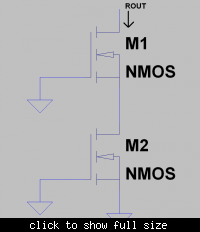thutch
Junior Member level 1
Hey all,
So, I think this is probably one of the neatest analysis tools I've seen. Using superposition of dependent sources and drawing a feedback diagram, producing some common results. I've seen it used to determine the output resistance of a source degenerated FET/cascode which I included some simple diagrams for to see. Basically, if you simplify the feedback diagram using Black's formula you get output resistance of a cascode (ro1+ro2+(gm1+gmb1)ro1ro2). Has anyone seen any other particularly insightful uses of this method? I feel like it gives a lot more insight, but maybe I'm just a sucker for block diagrams.


So, I think this is probably one of the neatest analysis tools I've seen. Using superposition of dependent sources and drawing a feedback diagram, producing some common results. I've seen it used to determine the output resistance of a source degenerated FET/cascode which I included some simple diagrams for to see. Basically, if you simplify the feedback diagram using Black's formula you get output resistance of a cascode (ro1+ro2+(gm1+gmb1)ro1ro2). Has anyone seen any other particularly insightful uses of this method? I feel like it gives a lot more insight, but maybe I'm just a sucker for block diagrams.

